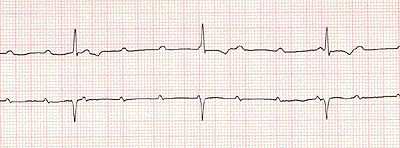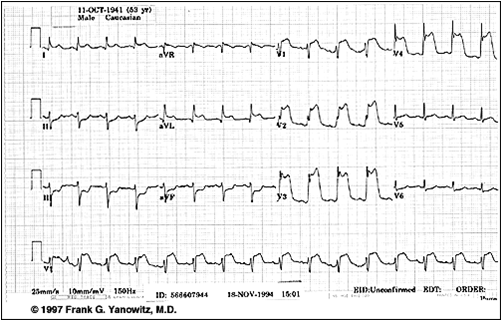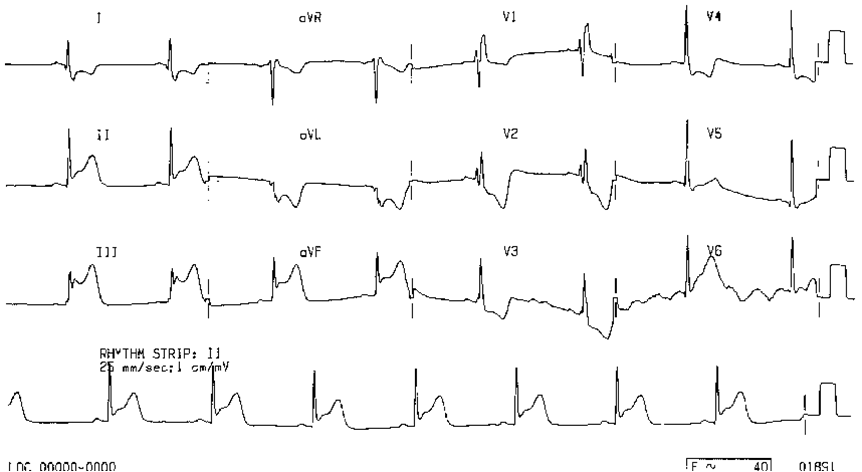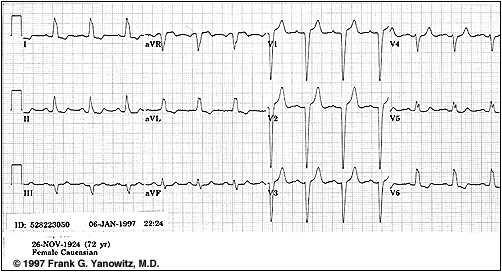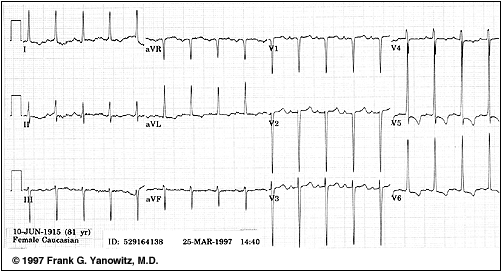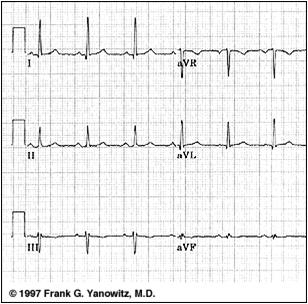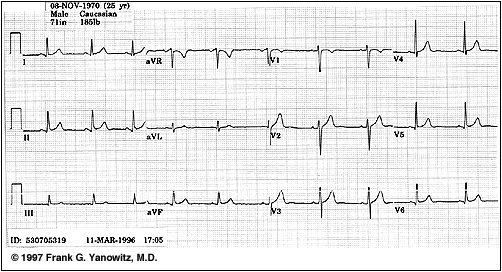Technology Exam 2

Review of material for exam 2. Including breathing circuits and ECG and ETCO2 monitoring.
- 1.
What are the two fundamental purposes of all anesthesia breathing systems? (click two answers)
- A.
Delivery of O2 & anesthetic gases.
- B.
To accurately measure amount of FGF going into vaporizer
- C.
To provide the perfect medium for application of Poiseuille's law
- D.
Elimination of CO2
Correct Answer(s)
A. Delivery of O2 & anesthetic gases.
D. Elimination of CO2 -
- 2.
All of the following will reduce Resistance in Laminar flow except...
- A.
Increasing Flow Rate
- B.
Increasing Viscosity
- C.
Increasing diameter of tubing.
- D.
Decreasing length of tubing.
- E.
Eliminating unnecessary valves
Correct Answer
B. Increasing Viscosity -
- 3.
In Laminar flow resistance is ______________ to flow rate.
- A.
Directly proportional
- B.
Equal
- C.
Indirectly Proportional
Correct Answer
C. Indirectly Proportional -
- 4.
What will doubling the radius of a tube do to resistance and flow?
- A.
Decrease resistance by half, increase flow 16 times
- B.
Increase resistance 16 times, decrease flow 16 times.
- C.
Double resistance and flow.
- D.
Decrease resistance 16 times, increase flow 16 times
Correct Answer
D. Decrease resistance 16 times, increase flow 16 times -
- 5.
If you half the radius of your breathing circuit what will this do resistance and flow?
- A.
Decrease flow by 16, increase resistance by 2.
- B.
Increase resistance by 16, decrease flow by 16.
- C.
Double resistance, half flow
- D.
Decrease resistance by 16, increase flow by 16.
Correct Answer
B. Increase resistance by 16, decrease flow by 16. -
- 6.
What is the difference between an open and a semi-open system?
- A.
Partial Rebreathing of gases.
- B.
Neutralization of CO2.
- C.
Presence of gas reservoir bag.
- D.
Presence of unidirectional valves
Correct Answer
C. Presence of gas reservoir bag. -
- 7.
How much FGF do you need in a semi-open system?
- A.
Less than minute ventilation to encourage rebreathing.
- B.
Equal to minute ventilation
- C.
4L/min
- D.
2-3 times minute ventilation
Correct Answer
D. 2-3 times minute ventilation -
- 8.
When using a semi-open circuit, what happens if your FGF drops below minute ventilation?
- A.
Nothing, gas flow SHOULD be below minute ventilation
- B.
The system then turns into a semi-closed circuit.
- C.
You run the risk of inflicting barotrauma on your pt.
- D.
An alarm will sound to alert you.
Correct Answer
B. The system then turns into a semi-closed circuit. -
- 9.
What is the primary determinant of whether a system if closed, semi closed, or semi open within our breathing circuits?
- A.
Presence of CO2 absorber
- B.
Size of the circuit
- C.
Amount of Fresh Gas Flow
- D.
Ability to add PEEP into circuit
Correct Answer
C. Amount of Fresh Gas Flow -
- 10.
Which of the following is NOT a characteristic of a semi-closed circuit?
- A.
Always provides for neutralization of CO2
- B.
Contains unidirectional valves
- C.
Always has a reservoir bag
- D.
Allows for Total rebreathing of gases
Correct Answer
D. Allows for Total rebreathing of gases -
- 11.
You are using a semi-closed system, and want to determine how much FGF to use. Your pt is breathing 600 Tv at 10 breaths per minute. How much FGF would be appropriate to maintain your semi-closed circuit?
- A.
4 L / min
- B.
12 L /min
- C.
~ 150 ml / min
- D.
6 L / min
Correct Answer
A. 4 L / minExplanation
FGF needs to be less than minute ventilation (not equal, not more). 150 ml/min is too little and would lead to total rebreathing.Rate this question:
-
- 12.
Which of the following is NOT true regarding a closed circuit?
- A.
Allows for total rebreathing of gases
- B.
Only to be used during controlled ventilations with open pop-off valve
- C.
Always provides for neutralization of CO2
- D.
Always contains unidirectional valves.
Correct Answer
B. Only to be used during controlled ventilations with open pop-off valve -
- 13.
Which non-rebreathing circuit contains a Fresh gas hose inside the expiratory limb?
- A.
Mapleson F (Jackson-Rees)
- B.
Mapleson A
- C.
Mapleson D (Bain)
- D.
Mapleson C
Correct Answer
C. Mapleson D (Bain) -
- 14.
Which type of non-rebreathing circuit is used almost exclusively in children?
- A.
Mapleson A
- B.
Mapleson D (Bain)
- C.
Nasal Cannula
- D.
Mapleson F (Jackson-Rees)
Correct Answer
D. Mapleson F (Jackson-Rees) -
- 15.
What two things do all non-rebreathing circuits lack? (two answers)
- A.
Unidirectional valves
- B.
Soda Lime CO2 absorption
- C.
Reservoir Bags
- D.
APL valves
Correct Answer(s)
A. Unidirectional valves
B. Soda Lime CO2 absorption -
- 16.
What could you do to decrease amount of CO2 (rebreathing) in a NRB circuit?
- A.
Decrease FGF
- B.
High tidal volume
- C.
Long Expiratory Pause
- D.
Close the APL valve
Correct Answer
C. Long Expiratory PauseExplanation
long expiratory pause allows for exhaled gas to be more thoroughly flushed out by high FGF since inspiration will draw on gases present in expiratory limb. PPT slide 18Rate this question:
-
- 17.
Which type of circuit is most efficient during Spontaneous Ventilation?
- A.
T-Piece
- B.
Mapleson D
- C.
Mapleson F
- D.
Mapleson A
Correct Answer
D. Mapleson A -
- 18.
Which type of circuit is most efficient during Controlled ventilation?
- A.
Mapleson D
- B.
Maplseon C
- C.
Mapleson A
- D.
Mapleson F
Correct Answer
A. Mapleson D -
- 19.
Identify the rhythm pictured above.
- A.
2:1 AV block
- B.
NSR
- C.
Premature Atrial Contraction
- D.
Hypokalemia
Correct Answer
C. Premature Atrial Contraction -
- 20.
Identify the above rhythm. (That is NOT a U-wave)
- A.
Hyperkalemia
- B.
Old MI
- C.
2:1 AV Block
- D.
NSR
Correct Answer
C. 2:1 AV Block -
- 21.
Identify the above rhythm.
- A.
V Fib
- B.
2nd Degree heart block
- C.
Dig Toxicity
- D.
Atrial Flutter
Correct Answer
D. Atrial Flutter -
- 22.
Identify the above rhythm.
- A.
3rd degree heart block
- B.
A Flutter
- C.
2:1 AV block
- D.
Long QT syndrome
Correct Answer
A. 3rd degree heart block -
- 23.
Identify the above rhythm.
- A.
Right Atrial Hypertrophy
- B.
Inferior wall MI
- C.
Dig Toxicity
- D.
Premature Atrial Contractions
Correct Answer
B. Inferior wall MI -
- 24.
Identify above rhythm.
- A.
Paced rhythm
- B.
A-fib
- C.
Old Inferior MI
- D.
LGL syndrome
Correct Answer
C. Old Inferior MIExplanation
Q waves leads 2 & 3Rate this question:
-
- 25.
Identify the above rhythm.
- A.
PVC's
- B.
2:1 AV Block
- C.
Atrial Fibrillation
- D.
Atrial Bigeminy
Correct Answer
D. Atrial Bigeminy -
- 26.
The above capnogram is indicative of what?
- A.
Pregnant patient
- B.
COPD or Bronchospasm
- C.
Malignant Hyperthermia
- D.
Spontaneous ventilation
Correct Answer
B. COPD or Bronchospasm -
- 27.
The following capnogram represents what?
- A.
Rebreathing of CO2
- B.
Esophageal intubation
- C.
Hyperventilation
- D.
COPD
Correct Answer
C. Hyperventilation -
- 28.
The above capnogram is indicative of what?
- A.
Hypoventilation
- B.
Pregnant pt
- C.
Normal capnogram
- D.
Rebreathing of CO2
Correct Answer
D. Rebreathing of CO2 -
- 29.
The above capnogram is indicative of what?
- A.
Curare Cleft
- B.
Malfunctioning valve
- C.
Normal capnogram
- D.
Lung Transplant
Correct Answer
A. Curare Cleft -
- 30.
The above capnogram represents what?
- A.
Hypoventilation
- B.
Air leak caused by incompetent valve
- C.
Lung Transplant
- D.
Normal Capnogram
Correct Answer
B. Air leak caused by incompetent valve -
- 31.
The above capnogram represents what?
- A.
Hypoventilation
- B.
COPD or Bronchospasm
- C.
Normal Capnogram
- D.
Rebreathing of CO2
Correct Answer
C. Normal Capnogram -
- 32.
The above capnogram represents what?
- A.
Curare Clefts in pt attempting to breath
- B.
Esophageal intubation
- C.
Cardiogenic oscillations in low frequency ventilation
- D.
Hiccups
Correct Answer
C. Cardiogenic oscillations in low frequency ventilation -
- 33.
The above capnogram is indicative of what?
- A.
Hyperventilation
- B.
Mucus Plug
- C.
Malignant Hyperthermia
- D.
CPR
Correct Answer
D. CPR -
- 34.
Identify the above rhythm.
- A.
A fib with Left Bundle branch
- B.
SVT
- C.
V-Fib
- D.
Anterior wall MI
Correct Answer
A. A fib with Left Bundle branch -
- 35.
Identify the above rhythm.
- A.
Atrial Flutter
- B.
Wide Complex Tachycardia
- C.
Cardiac Ischemia
- D.
V Tach
Correct Answer
B. Wide Complex TachycardiaExplanation
Look for the P waves along V1, they are there.Rate this question:
-
- 36.
Identify the above ECG rhythm.
- A.
Acute Inferior MI
- B.
Left Bundle Branch Block
- C.
Acute Anterior/ Lateral MI
- D.
Wolfe-parkinson-white syndrome
Correct Answer
C. Acute Anterior/ Lateral MI -
- 37.
Identify the above ECG rhythm.
- A.
2nd degree heart block
- B.
Hyperkalemia
- C.
Sinus Tach
- D.
NSR
Correct Answer
D. NSR -
- 38.
Identify the above rhythm.
- A.
Digitalis Toxicity
- B.
HyperKalemia
- C.
A fib
- D.
Anterior Wall MI
Correct Answer
A. Digitalis ToxicityExplanation
.Dig toxicity has a characteristic downsloping ST depressionRate this question:
-
- 39.
Identify the above ECG rhythm.
- A.
NSR
- B.
Hyperkalemia
- C.
Junctional Rhythm
- D.
Digitalis Effect
Correct Answer
B. Hyperkalemia -
- 40.
Identify the above ECG rhythm. Examine V5 lead for clues.
- A.
Digitalis Effect
- B.
Anterior wall MI
- C.
Hypokalemia
- D.
Premature Atrial Contraction
Correct Answer
C. Hypokalemia -
- 41.
Identify the above ECG rhythm.
- A.
Digitalis Toxicity
- B.
NSR
- C.
Inferior wall MI
- D.
Wolff-Parkinson-White Syndrome
Correct Answer
D. Wolff-Parkinson-White SyndromeExplanation
Characteristic Slurred upstroke to QRS indicating pre-excitation (delta wave).Rate this question:
-
- 42.
Identify the above rhythm.
- A.
Paced Rhythm
- B.
Wolff Parkinson White
- C.
NSR
- D.
Junctional Rhythm
Correct Answer
A. Paced Rhythm -
- 43.
Identify the above rhythm.
- A.
NSR
- B.
Junctional Rhythm
- C.
Hypokalemia
- D.
1st degree heart block
Correct Answer
B. Junctional RhythmExplanation
Inverted P wave with short PR intervalRate this question:
-
- 44.
Identify the above ECG.
- A.
Digitalis effect
- B.
WPW syndrome
- C.
Right Atrial Hypertrophy
- D.
Left ventricular hypertrophy
Correct Answer
C. Right Atrial HypertrophyExplanation
large P waves in leads 2 & 3Rate this question:
-
- 45.
Identify the above ECG rhythm.
- A.
Old MI
- B.
Acute Anterior Wall MI
- C.
Acute Inferior Wall MI
- D.
Right Bundle Branch Block
Correct Answer
B. Acute Anterior Wall MI -
- 46.
Identify the above rhythm.
- A.
Posterior Wall MI
- B.
Hyperkalemia
- C.
Acute Inferior Wall MI
- D.
WPW Syndrome
Correct Answer
C. Acute Inferior Wall MI -
- 47.
Identify the above rhythm.
- A.
NSR
- B.
Inferior Wall MI
- C.
Left Bundle Branch Block
- D.
High Lateral MI
Correct Answer
C. Left Bundle Branch Block -
- 48.
Identify the above ECG.
- A.
Acute Lateral MI
- B.
Left Ventricular Hypertrophy
- C.
Old MI
- D.
Hypokalemia
Correct Answer
B. Left Ventricular Hypertrophy -
- 49.
Is there any axis deviation in the above ECG?
- A.
Yes, Left axis deviation.
- B.
Yes, Right axis deviation.
- C.
Yes, deviation of undetermined cause.
- D.
Nope, looks normal to me.
Correct Answer
D. Nope, looks normal to me. -
- 50.
Identify the above ECG.
- A.
NSR
- B.
Old MI
- C.
Right Ventricular Hypertrophy
- D.
A-fib
Correct Answer
A. NSR -
Quiz Review Timeline +
Our quizzes are rigorously reviewed, monitored and continuously updated by our expert board to maintain accuracy, relevance, and timeliness.
-
Current Version
-
May 22, 2019Quiz Edited by
ProProfs Editorial Team -
Oct 18, 2008Quiz Created by
Scottishduffy
- Aeronautics Quizzes
- Aerospace Quizzes
- Agricultural Science Quizzes
- Astrology Quizzes
- Astronomy Quizzes
- Atom Quizzes
- Biochemistry Quizzes
- Biology Quizzes
- Biomechanics Quizzes
- Biostatistics Quizzes
- Biotechnology Quizzes
- Botany Quizzes
- Branches Of Science Quizzes
- Chemistry Quizzes
- Cytology Quizzes
- Easy Science Quizzes
- Ecology Quizzes
- Electrical Quizzes
- Embryology Quizzes
- Endocrinology Quizzes
- Environmental Science Quizzes
- Epidemiology Quizzes
- Experiment Quizzes
- Forestry Quizzes
- Fossil Quizzes
- Gas Quizzes
- General Science Quizzes
- Genetics Quizzes
- Histology Quizzes
- Human Biology Quizzes
- Integrated Science Quizzes
- Invention Quizzes
- Library Science Quizzes
- Lighting Quizzes
- Liquid Quizzes
- Marine Biology Quizzes
- Microbiology Quizzes
- Molecular Biology Quizzes
- Nature Quizzes
- Neuroscience Quizzes
- Nuclear Science Quizzes
- Oceanography Quizzes
- Physics Quizzes
- Psychology Quizzes
- Science And Technology Quizzes
- Science Glossary Quizzes
- Science Knowledge Quizzes
- Science Practice Quizzes
- Scientific Method Quizzes
- Scientific Notation Quizzes
- Soil Science Quizzes
- Solar System Quizzes
- Solid Quizzes
- Zoology Quizzes
 Back to top
Back to top






